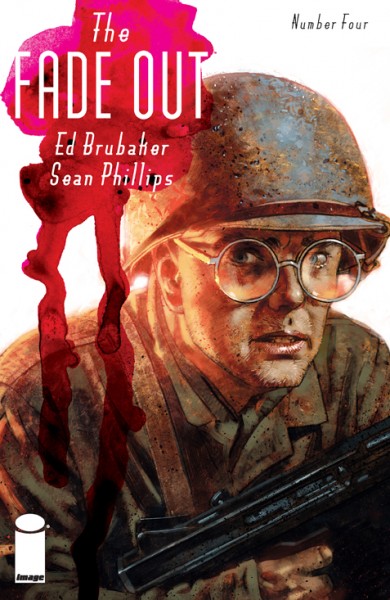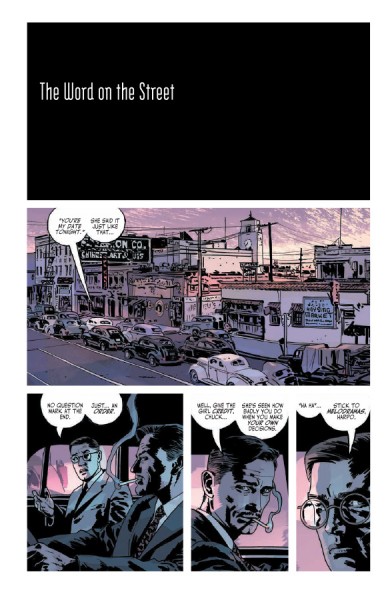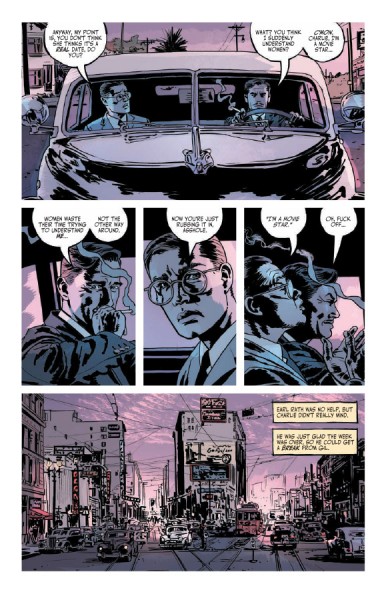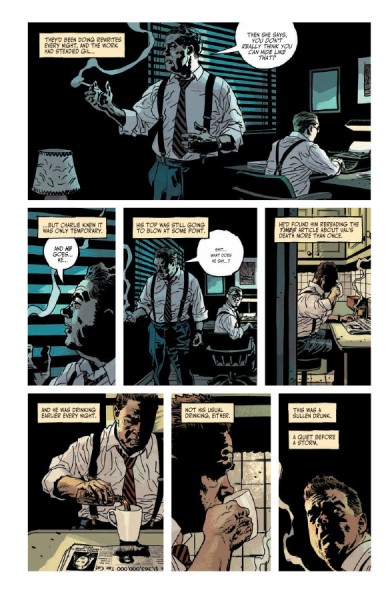The Fade Out #4 Review
"Famous Friends"
After Ed Brubaker and Sean Phillips spent issue #3 of
The Fade Out introducing the new character Maya Silver – in very promising fashion, I might add – they return in
The Fade Out #4 to screenwriter Charlie Parish, who was the central character of the first two issues of the series. The new issue is the most “Old Hollywood” issue yet, and it’s great because of that, though it also introduces another layer to the mystery of Val Sommer’s murder.

Charlie is somehow involved in Val’s murder, though he blacked out so he doesn’t know anything beyond the fact that he woke up in the same room as Val’s dead body. He is starting to remember bits and pieces of earlier in the night, almost like in a dream. In
The Fade Out #4, he sees a photograph of a man whom he recognizes from one of these shards of memory. Instantly, Charlie suspects that this man – who may be an FBI agent – is involved in Val’s death.
When he realizes this and goes back to the house of the photographer who took the photo of the man, not only is the photographer’s house burnt down (with him dead inside), but Charlie gets a glimpse of the mysterious possible-FBI agent. His presence would seem way too unlikely to be a coincidence and strongly suggests that the man in the glasses was involved in the fire – and by extension in Val’s death.

Charlie is a complex character, which makes him very interesting to follow in
The Fade Out #4 and earlier in the series. He can be selfish and conniving, yet he also tries to be a good friend. He covered up his involvement in Val’s death, yet also cared deeply about her and truly wants to find out what happened to her while everyone else at the Victory Street Pictures seems content to let her death pass by and move on. We learn about Charlie’s military service in this issue, but it doesn’t present him as a hero but rather furthers the image of him as damaged and unpredictable.
In the back notes of the last issue of
Fatale, Brubaker discussed how both of his grandparents were involved in Hollywood (his grandfather was a screenwriter named John Paxton), so I was extra fascinated by the attention to detail to that world in
The Fade Out #4. At one point, Charlie, while hanging out with buddy and big time star Earl Rath, runs in to old pal Clark Gable. The comic then recounts how Charlie teamed up with Gable during his crusade to document World War II and the two became friends. It’s pretty seamless how Brubaker and Phillips combine fictional characters (Charlie and Earl) with real movie stars (Gable).

Sean Phillips’ art is sometimes less detailed, but he does a great job in
The Fade Out #4. When he shows us Charlie meeting Clark Gable, it’s immediately clear to anyone who knows what Gable looks like that it’s him. Phillips also nicely demarcates a number of different worlds in Hollywood at the time, from the fancy supper clubs where stars were watched by the press to the seedy photographer’s studio, a place where you can see a picture of actor Ron Reagan while also getting some pornographic pictures.

The introduction of the FBI agent certainly deepens the mystery occurring in
The Fade Out, but I really like the pace of this series. The mystery is compelling and driving the plot, but it doesn’t feel like the point of the series. Instead, the issues are mainly concerned with showing the flawed personalities that were involved in Hollywood and motion pictures during the 1940s. These two elements dovetail wonderfully in
The Fade Out #4, which makes it hard to wait for the next issue to appear.
Pros
- Charlie Parish is interesting even when he's unlikable
- The introduction of the man in glasses furthers the mystery
- The handling of the Hollywood elements feels very authentic
- Phillips shows us various sides of the movie business
Cons
- The linked timing of Charlie's realization of the man in glasses and the fire seems a little unrealistic